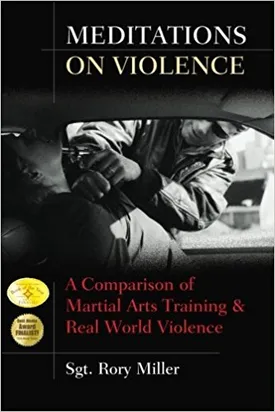Meditations on Violence: A Comparison of Martial Arts Training & Real World Violence by Rory Miller
When it comes to navigating the complexities of violence, few have the insight and experience of Rory Miller. In his book “Meditations on Violence: A Comparison of Martial Arts Training & Real World Violence”, Miller draws upon a quarter century of firsthand experience to reflect on the realities of violence, and what martial arts training can offer to prepare oneself for confronting it.
For Miller, violence is a conversation, a uniquely human activity, motivated by underlying objectives and principles. From this perspective, violence is just one tool available for meeting one's goals. Martial arts training and other forms of self-defense, in contrast, offer a framework for navigating violent encounters. To Miller, martial arts are training regimens that provide useful weapons against the uncertainties of violence and its aftermath.
Through his book, Miller explores the role martial arts training plays in our lives in various ways, delving deep into the idea of what constitutes “real” violence. He delves into the delusions held by both participants and spectators of violence, pointing out how martial arts training is often misguidedly thought of as a way of “winning” a fight.
In his exploration of violence, Miller talks about the importance of awareness, both of our surroundings and our mental state. He breaks down the mental and emotional impulses that lead up to and follow a violent encounter, and emphasizes how quickly and easily volatile situations can arise. He then examines the different types of martial arts, which are designed to complement and channel the human impulse to protect oneself without losing sight of one's ethical and moral boundaries.
Miller extends his assessment, looking into the effects of violence on the psyche and the scars that often linger long after a violent interaction has been finished. He focuses in particular on the damaging effects of unproductive anger, and how martial arts can offer a productive vehicle for venting that anger. He cites several examples of individuals whose violence was exacerbated by a lack of self-control and insight into the consequences of their own actions.
Finally, Miller goes a step further and looks at the impact that watching violence can have. He looks at how violence can be commodified and normalized, citing sport-like boxing as well as film and video games as prime examples. In his conclusion, he drives home the idea that martial arts can be used as a beneficial practice, a tool to help us understand the underlying causes of violence and to use our own inner resilience to confront violent situations bravely and responsibly.
At its core, “Meditations on Violence: A Comparison of Martial Arts Training & Real World Violence" provides an invaluable education on violence, written by someone who deeply understands the nature of violence and its consequences. Miller's book is both an exploration of violence and its potential for destruction, as well as a testament to its strengths and capacity for positive transformation. It is a must-read for anyone wanting to gain greater insight into this complex topic.

